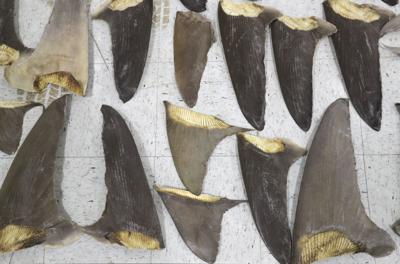She also dishes on what the real threat is in the deep blue sea. Buzz60鈥檚 Tony Spitz has the details.聽
MIAMI 鈥� The U.S. is poised to ban the lucrative trade in shark fins, a move conservationists hope will help protect millions of sharks butchered every year to satisfy demand in China and other parts of Asia.
The practice of shark finning, whereby sharks are caught for their fins and their carcasses then dumped back into the ocean, has been banned in U.S. waters for decades. But the U.S. remains a major hub for the brisk trade where the fins of as many as 73 million sharks are cut off around the world each year.
5 things you might not know about sharks
1. Humans vs. sharks
UpdatedWhen it comes to humans versus sharks, the numbers are staggering. An average of 6 humans are killed worldwide each year by sharks, while humans kill 100 million to 273 million sharks annually, selling their body parts in markets around the globe.

A surfer rides the waves along Mexico's Pacific Coast near El Rancho village, Wednesday, May 28, 2008. Sharks have attacked three surfers in the area in less than a month, two fatally. (AP Photo/Eduardo Verdugo)
2. They're old
UpdatedSharks were swimming in the ocean depths long before dinosaurs climbed onto land. Researchers say sharks date back 400 million years.

In this March 16, 2011, photo children look at the Shark Jaw of a Megalodon, a prehistoric shark, at the Museum of Nature and Science in Dallas. The jaw is 11 feet wide and almost 9 feet tall, it consists of 182 teeth collected from South Carolina rivers. (AP Photo/Rich Matthews)
3. 465 species
UpdatedThere are 465 known species of sharks, ranging from the tiny spined pygmy shark (about 8 inches long) to the whale shark (about 50 feet in length). Each of these sharks plays a role in keeping other fish populations in check, which is why hunting and killing of sharks can create great imbalances in ocean life.

A diver feeds fish to a male whale shark at the Hakkeijima Sea Paradise aquarium-amusement park complex in Yokohama near Tokyo, Saturday, June 11, 2011.(AP Photo/Itsuo Inouye)
4. Not a 'miracle of evolution'
UpdatedRichard Dreyfuss' character in "Jaws" claimed that the shark is "a miracle of evolution," and that the only thing it does is "swim and eat and make little sharks, that's all." That's not exactly correct.
Sharks have to eat, like every other living organism, but they don't mate until they are 12 to 15 years old. The females give birth to one or two pups at a time, making it difficult for the sharks' reproduction rates to keep pace with the annual kill rates.

FILE - In this Tuesday, July 3, 2012 photo, Rima Jabado, a marine scientist and shark researcher pulls up a baby spottail shark from the water for the tagging off the Dubai coast, United Arab Emirates. (AP Photo/Kamran Jebreili, File)
5. A sixth sense
UpdatedSharks are extraordinary hunters, who use six senses. In addition to smell, hearing, touch, taste and sight, they also are gifted with electroreception 鈥� special pores around their faces detect electrical currents from other organisms and allow them to deftly hone in on their prey.

A Sand Tiger Shark swims in its aquarium at the Zoo-Aquarium in Berlin, Germany, Tuesday, Nov. 9, 2010. (AP Photo/Michael Sohn)
Visit The Mercury News (San Jose, Calif.) at








































